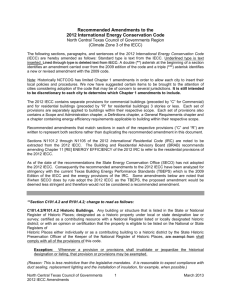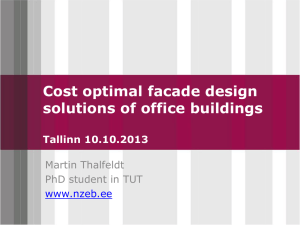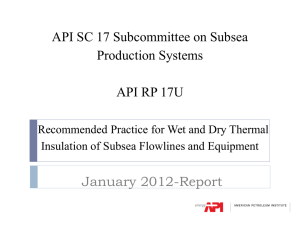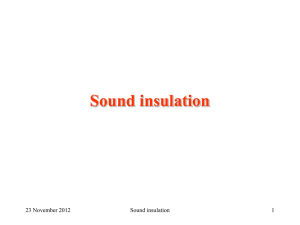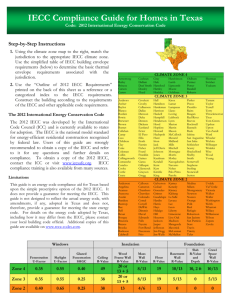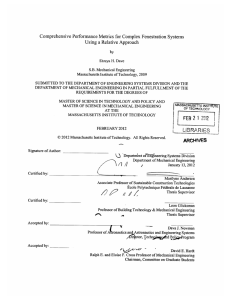2006 IECC Amendments
advertisement
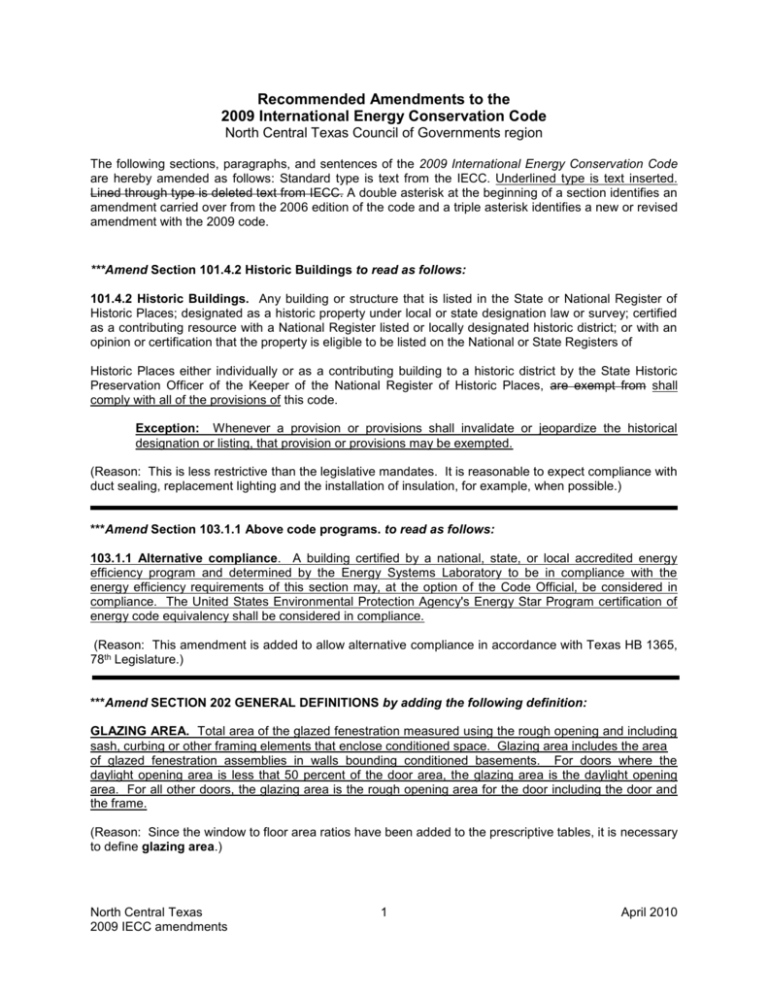
Recommended Amendments to the
2009 International Energy Conservation Code
North Central Texas Council of Governments region
The following sections, paragraphs, and sentences of the 2009 International Energy Conservation Code
are hereby amended as follows: Standard type is text from the IECC. Underlined type is text inserted.
Lined through type is deleted text from IECC. A double asterisk at the beginning of a section identifies an
amendment carried over from the 2006 edition of the code and a triple asterisk identifies a new or revised
amendment with the 2009 code.
***Amend Section 101.4.2 Historic Buildings to read as follows:
101.4.2 Historic Buildings. Any building or structure that is listed in the State or National Register of
Historic Places; designated as a historic property under local or state designation law or survey; certified
as a contributing resource with a National Register listed or locally designated historic district; or with an
opinion or certification that the property is eligible to be listed on the National or State Registers of
Historic Places either individually or as a contributing building to a historic district by the State Historic
Preservation Officer of the Keeper of the National Register of Historic Places, are exempt from shall
comply with all of the provisions of this code.
Exception: Whenever a provision or provisions shall invalidate or jeopardize the historical
designation or listing, that provision or provisions may be exempted.
(Reason: This is less restrictive than the legislative mandates. It is reasonable to expect compliance with
duct sealing, replacement lighting and the installation of insulation, for example, when possible.)
***Amend Section 103.1.1 Above code programs. to read as follows:
103.1.1 Alternative compliance. A building certified by a national, state, or local accredited energy
efficiency program and determined by the Energy Systems Laboratory to be in compliance with the
energy efficiency requirements of this section may, at the option of the Code Official, be considered in
compliance. The United States Environmental Protection Agency's Energy Star Program certification of
energy code equivalency shall be considered in compliance.
(Reason: This amendment is added to allow alternative compliance in accordance with Texas HB 1365,
78th Legislature.)
***Amend SECTION 202 GENERAL DEFINITIONS by adding the following definition:
GLAZING AREA. Total area of the glazed fenestration measured using the rough opening and including
sash, curbing or other framing elements that enclose conditioned space. Glazing area includes the area
of glazed fenestration assemblies in walls bounding conditioned basements. For doors where the
daylight opening area is less that 50 percent of the door area, the glazing area is the daylight opening
area. For all other doors, the glazing area is the rough opening area for the door including the door and
the frame.
(Reason: Since the window to floor area ratios have been added to the prescriptive tables, it is necessary
to define glazing area.)
North Central Texas
2009 IECC amendments
1
April 2010
***Add Section 401.2.1. Compliance software tools. to read as follows:
401.2.1. Compliance software tools. Software tools used to demonstrate energy code compliance that
are deemed acceptable by the building official. The PNL program REScheck™ is not acceptable for
residential compliance.
Exception:
When the UA Alternate compliance approach method is used, the compliance
certificate must demonstrate that the maximum glazing area does not exceed 15% of the conditioned
floor area.
(Reason: This amendment is added to satisfy the “not less restrictive” requirement when adopting
subsequent editions of energy codes in accordance with Texas SB 5, 77 th Legislature and reflects the
findings of ESL report to SECO.)
***Amend Section 402.1.1 Insulation and fenestration criteria. to read as follows:
402.1.1 Insulation and fenestration criteria. The building thermal envelope shall meet the requirements
of Table 402.1.1 based on the climate zone specified in Chapter 3. The use of Table 402.1.1 is limited to
a maximum glazing are or 15% window area to floor area ratio.
When compliance using Table 402.1.1 is demonstrated with a ceiling R-value of R30, no more than 33%
of the total projected ceiling area may be of cathedral type construction (ceiling joist/roof rafter assembly)
and the required insulation R-value for the cathedral type construction may be reduced to a minimum of
R22 when the remaining ceiling area R-value is increased to a minimum of R38.
(Reason: This amendment is added to satisfy the “not less restrictive” requirement when adopting
subsequent editions of energy codes in accordance with Texas SB 5, 77 th Legislature and reflects the
findings of ESL report to SECO.
This amendment is compatible with the previous amendments increasing the number of builders who
could use the "simplified prescriptive" approach of the IRC and incorporates the Home Builder
Association prescriptive package proposal. The addition of “Ceiling Joist/Roof Rafter Assembly”
requirements protect such assemblies from the damage likely to occur if greater amounts of insulation
were attempted in such assemblies.)
***Amend Section 402.1.4 Total UA alternative. to read as follows:
{original paragraph to remain unchanged}
The use of Table 402.1.3 is limited to a maximum glazing are or 15% window area to floor area ratio.
(Reason: This amendment is added to satisfy the “not less restrictive” requirement when adopting
subsequent editions of energy codes in accordance with Texas SB 5, 77 th Legislature and reflects the
findings of ESL report to SECO.)
North Central Texas
2009 IECC amendments
2
April 2010
***Add Section 402.2.12. Insulation installed in walls. to read as follow:
Section 402.2.12. Insulation installed in walls. Insulation batts installed in walls shall be totally
surrounded by an enclosure on all sides consisting of framing lumber, gypsum, sheathing, wood structural
panel sheathing or other equivalent material approved by the building official.
(Reason: This will increase the performance of the batt insulation by eliminating the potential for drafts
and insure that the batt insulation stays in place)
***Amend Section 402.3.6 Replacement fenestration. to read as follows:
Section 402.3.6 Replacement fenestration. Where some or all of an existing fenestration unit is
replaced with a new fenestration product, including sash and glazing, the replacement fenestration unit
shall meet the applicable requirements for U-factor and SHGC in Table 402.1.1.
Exceptions:
For buildings constructed in conformance with an energy code as required by State of
Texas Senate Bill Number 5, 77th Legislature, replacement fenestration units may comply with the
original construction documents or applicable U-factor in Table 402.1.1.
(Reason: This amendment is added to satisfy the “not less restrictive” requirement when adopting
subsequent editions of energy codes in accordance with Texas SB 5, 77 th Legislature and to provide for
reasonable compliance for structures built after the adoption of codes in accordance with SB 5, 77 th
Legislature.)
(NOTE: Need to question ESL regarding duct trade offs)
***Add Exception No. 2. to Section 403.2.1. Insulation to read as follows:
Section 403.2.1. Insulation. Supply and return ducts shall be insulated to a minimum of R-8. Ducts in
floor trusses shall be insulated to a minimum of R-6.
Exceptions:
1. Ducts or portions thereof located completely inside the building thermal envelope.
2. Supply and return ducts can be insulated to a minimum of R-6, if the efficiency of the
cooling equipment is upgraded to one SEER point above the NAECA (National
Appliance Energy Conservation Act) Standard.
(Reason: To provide an equivalent tradeoff to permit the use of R-6 duct insulation.)
***Add Section 501.3. Compliance software tools. to read as follows:
Section 501.3. Compliance software tools. Software tools used to demonstrate energy code
compliance that are deemed acceptable by the building official may only utilize the 2009 Edition of the
International Energy Conservation Code or the 2007 Edition of AHSRAE 90.1 Energy Standard for
Buildings Except Low-rise Residential Buildings when code edition and/or standard selection is available.
(Reason: The nonresidential provisions of the 2006 IECC are deemed “not less restrictive” in accordance
with Texas SB 5, 77th Legislature.)
END
North Central Texas
2009 IECC amendments
3
April 2010



